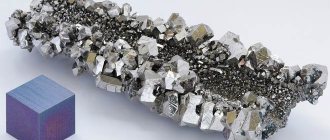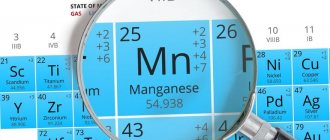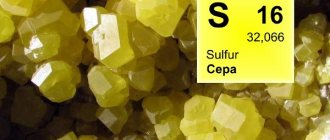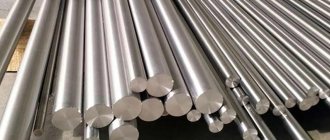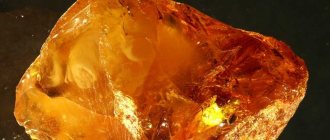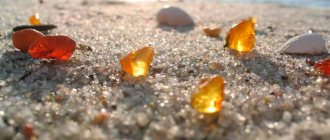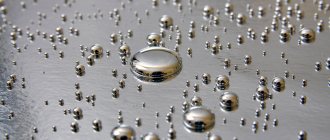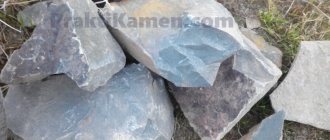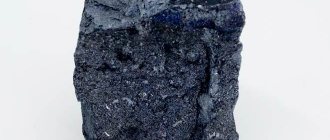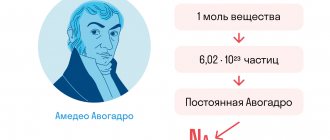Crystal Titanium Bar
Titanium
– lightweight durable metal of silver-white color. It exists in two crystal modifications: α-Ti with a hexagonal close-packed lattice, β-Ti with cubic body-centered packing, the temperature of the polymorphic transformation α↔β is 883 °C. Titanium and titanium alloys combine lightness, strength, high corrosion resistance, low thermal coefficient expansion, ability to operate in a wide temperature range.
- Structure
- Properties
- Reserves and production
- Origin
- Application
- Classification
- Physical properties
- Optical properties
- Crystallographic properties
See also:
Chromium
– structure and physical properties
STRUCTURE
Crystal crystal structure
Titanium has two allotropic modifications. The low-temperature modification, existing up to 882 °C, has a hexagonal close-packed lattice with periods a = 0.296 nm and c = 0.472 nm. The high-temperature modification has a body-centered cube lattice with a period a = 0.332 nm. The polymorphic transformation (882 °C) with slow cooling occurs according to the normal mechanism with the formation of equiaxed grains, and with rapid cooling - according to the martensitic mechanism with the formation of an acicular structure. Titanium has high corrosion and chemical resistance due to the protective oxide film on its surface. It does not corrode in fresh and sea water, mineral acids, aqua regia, etc.
PROPERTIES
Titanium crystals
Melting point 1671 °C, boiling point 3260 °C, density of α-Ti and β-Ti, respectively, is 4.505 (20 °C) and 4.32 (900 °C) g/cm³, atomic density 5.71 × 1022 at/ cm³. Plastic, weldable in an inert atmosphere. Technical titanium used in industry contains impurities of oxygen, nitrogen, iron, silicon and carbon, which increase its strength, reduce ductility and affect the temperature of the polymorphic transformation, which occurs in the range of 865-920 °C. For technical Titanium grades VT1-00 and VT1-0, density is about 4.32 g/cm3, tensile strength is 300-550 MN/m2 (30-55 kgf/mm2), relative elongation is not lower than 25%, Brinell hardness is 1150-1650 MN /m2 (115-165 kgf/mm2). Is paramagnetic. Configuration of the outer electron shell of the Ti 3d24s2 atom.
It has a high viscosity and, during machining, is prone to sticking to the cutting tool, and therefore requires the application of special coatings to the tool and various lubricants.
At ordinary temperatures it is covered with a protective passivating film of TiO2 oxide, making it corrosion resistant in most environments (except alkaline). Titanium dust tends to explode. Flash point 400 °C.
Obtaining titanium
The metal source is titanium dioxide.
Its formation occurs during the processing of ilmenite. As a result, titanium slag is formed, which is subjected to further processing. Sulfuric acid is added to the concentrate, which produces titanium dioxide.
Another method is to combine with carbon (coke), chlorine and further heating in the presence of magnesium.
Calcium reduction of titanium dioxide is also used. The last process involves conducting an electric current, which leads to the decomposition of calcium oxide (oxygen at the anode and calcium itself).
Oxygen acts as an oxidizing agent, calcium, being a metal, moves to the cathode, simultaneously reducing titanium. The process happens several times. The outcome of the reaction is a titanium sponge that requires cleansing.
RESERVES AND PRODUCTION
Titanium crystals
Main ores: ilmenite (FeTiO3), rutile (TiO2), titanite (CaTiSiO5).
As of 2002, 90% of mined titanium was used to produce titanium dioxide TiO2. World production of titanium dioxide was 4.5 million tons per year. Confirmed reserves of titanium dioxide (excluding Russia) are about 800 million tons. As of 2006, according to the US Geological Survey, in terms of titanium dioxide and excluding Russia, reserves of ilmenite ores amount to 603-673 million tons, and rutile ores - 49.7- 52.7 million tons. Thus, at the current rate of production, the world's proven reserves of titanium (excluding Russia) will last for more than 150 years.
Russia has the second largest reserves of titanium in the world, after China. The mineral resource base of titanium in Russia consists of 20 deposits (of which 11 are primary and 9 alluvial), fairly evenly distributed throughout the country. The largest of the explored deposits is located 25 km from the city of Ukhta (Komi Republic). The deposit's reserves are estimated at 2 billion tons.
Titanium ore concentrate is subjected to sulfuric acid or pyrometallurgical processing. The product of sulfuric acid treatment is titanium dioxide powder TiO2. Using the pyrometallurgical method, the ore is sintered with coke and treated with chlorine, producing titanium tetrachloride vapor, which is reduced at 850 °C with magnesium.
The resulting titanium “sponge” is melted down and cleaned. Ilmenite concentrates are reduced in electric arc furnaces, followed by chlorination of the resulting titanium slag.
History of discovery
The appearance of a new element is associated with the names of Gregor and Klaproth. Both singled it out almost simultaneously in 1791 and 1795. respectively.
Martin Heinrich Klaproth
In 1805, it was isolated again by Vauquelin from anatase. Moreover, pure titanium was obtained in Holland more than a century after its isolation.
ORIGIN
Titanium Ore
Titanium is in 10th place in terms of prevalence in nature. The content in the earth's crust is 0.57% by weight, in sea water - 0.001 mg/l. In ultramafic rocks 300 g/t, in basic rocks - 9 kg/t, in acidic rocks 2.3 kg/t, in clays and shales 4.5 kg/t. In the earth's crust, titanium is almost always tetravalent and is present only in oxygen compounds. Not found in free form. Under conditions of weathering and precipitation, titanium has a geochemical affinity with Al2O3. It is concentrated in bauxites of the weathering crust and in marine clayey sediments. Titanium is transferred in the form of mechanical fragments of minerals and in the form of colloids. Up to 30% TiO2 by weight accumulates in some clays. Titanium minerals are resistant to weathering and form large concentrations in placers. More than 100 minerals containing titanium are known. The most important of them are: rutile TiO2, ilmenite FeTiO3, titanomagnetite FeTiO3 + Fe3O4, perovskite CaTiO3, titanite CaTiSiO5. There are primary titanium ores - ilmenite-titanomagnetite and placer ores - rutile-ilmenite-zircon. Titanium deposits are located in South Africa, Russia, Ukraine, China, Japan, Australia, India, Ceylon, Brazil, South Korea, and Kazakhstan. In the CIS countries, the leading places in explored reserves of titanium ores are occupied by the Russian Federation (58.5%) and Ukraine (40.2%).
Titanium ore cost
Titanium is considered one of the most expensive non-ferrous metals. It is produced in the form of pipes, plates, wires, powders, sheets. Titanium is usually labeled based on the purity of the products. The cost directly depends on the grade of ore. For example, the price for titanium powder “PTM-1” is 7,500 rubles per 1 kg.
Titanium ore is a raw material in demand on the modern market. The increased strength of the metal, along with its resistance to corrosion, makes it possible to develop promising ways to use the element.
Share the article with your friends on social networks. Leave your interesting facts and knowledge about titanium ore in the comments.
APPLICATION
Titanium products
Titanium alloys play an important role in aviation technology, where they strive to obtain the lightest structure combined with the necessary strength. Titanium is lightweight compared to other metals, but at the same time can operate at high temperatures. Titanium alloys are used to make the casing, fastening parts, power kit, chassis parts, and various units. These materials are also used in the construction of aircraft jet engines. This allows you to reduce their weight by 10-25%. Titanium alloys are used to produce compressor discs and blades, air intake and guide vane parts, and fasteners.
Titanium and its alloys are also used in rocket science. Due to the short-term operation of engines and the rapid passage of dense layers of the atmosphere in rocket science, the problems of fatigue strength, static endurance and partly creep are eliminated to a large extent.
Due to its insufficiently high thermal strength, technical titanium is not suitable for use in aviation, but due to its exceptionally high corrosion resistance, in some cases it is indispensable in the chemical industry and shipbuilding. Thus, it is used in the manufacture of compressors and pumps for pumping such aggressive media as sulfuric and hydrochloric acid and their salts, pipelines, shut-off valves, autoclave, various types of containers, filters, etc. Only titanium is corrosion resistant in environments such as wet chlorine, aqueous and acidic chlorine solutions, therefore equipment for the chlorine industry is made from this metal. Heat exchangers are made from titanium that operate in corrosive environments, for example, nitric acid (non-smoking). In shipbuilding, titanium is used for the manufacture of propellers, plating of ships, submarines, torpedoes, etc. Shells do not stick to titanium and its alloys, which sharply increase the resistance of the vessel as it moves.
Titanium alloys are promising for use in many other applications, but their spread in technology is hampered by the high cost and scarcity of titanium.
Titanium – Ti
| Molecular weight | 47.88 g/mol |
| origin of name | The mineral got its name in honor of the Titans, characters from ancient Greek mythology, the children of Gaia. |
| IMA status | confirmed in 2010 |
Physico-chemical characteristics
The properties of the metal are well studied:
- Reacts easily with acids even at low concentrations.
- This is a refractory metal: the melting point is 1670°C. It takes twice as much to boil.
- It is plastic and becomes brittle in the cold (-80°C).
- Strength is affected by the degree of purification, but not by temperature.
- At room temperature it is covered with an oxide film, which makes it resistant to corrosion (excluding alkalis).
- At normal pressure, there are two types of titanium with different types of lattices: high- and low-temperature.
Lightness, almost weightlessness, is the main property by which titanium can be easily distinguished from other metals.
| Properties of the atom | |
| Name, symbol, number | Titanium (Ti), 22 |
| Atomic mass (molar mass) | 47.867(1) a. e.m. (g/mol) |
| Electronic configuration | [Ar] 3d2 4s2 |
| Atomic radius | 147 pm |
| Chemical properties | |
| Covalent radius | 132 pm |
| Ion radius | (+4e)68 (+2e)94 pm |
| Electronegativity | 1.54 (Pauling scale) |
| Electrode potential | −1,63 |
| Oxidation states | 2, 3, 4 |
| Ionization energy (first electron) | 657.8 (6.8281) kJ/mol (eV) |
| Thermodynamic properties of a simple substance | |
| Density (at normal conditions) | 4.54 g/cm³ |
| Melting temperature | 1670 °C 1943 K |
| Boiling temperature | 3560 K |
| Ud. heat of fusion | 18.8 kJ/mol |
| Ud. heat of vaporization | 422.6 kJ/mol |
| Molar heat capacity | 25.1 J/(K mol) |
| Molar volume | 10.6 cm³/mol |
| Crystal lattice of a simple substance | |
| Lattice structure | hexagonal close-packed (α-Ti) |
| Lattice parameters | a=2.951 s=4.697 (α-Ti) |
| c/a ratio | 1,587 |
| Debye temperature | 380 K |
| Other characteristics | |
| Thermal conductivity | (300 K) 21.9 W/(m K) |
| CAS number | 7440-32-6 |
Due to the increased viscosity, mechanical processing of the metal is difficult. This drawback is eliminated by lubricating the tool with special compounds.
PHYSICAL PROPERTIES
| Mineral color | Silver gray |
| Stroke color | grayish black |
| Transparency | opaque |
| Shine | metal |
| Cleavage | No |
| Hardness (Mohs scale) | 4 |
| Kink | hackly |
| Strength | pliable |
| Density (measured) | 4.503 g/cm3 |
| Radioactivity (GRapi) | 0 |
| Magnetism | paramagnetic |
